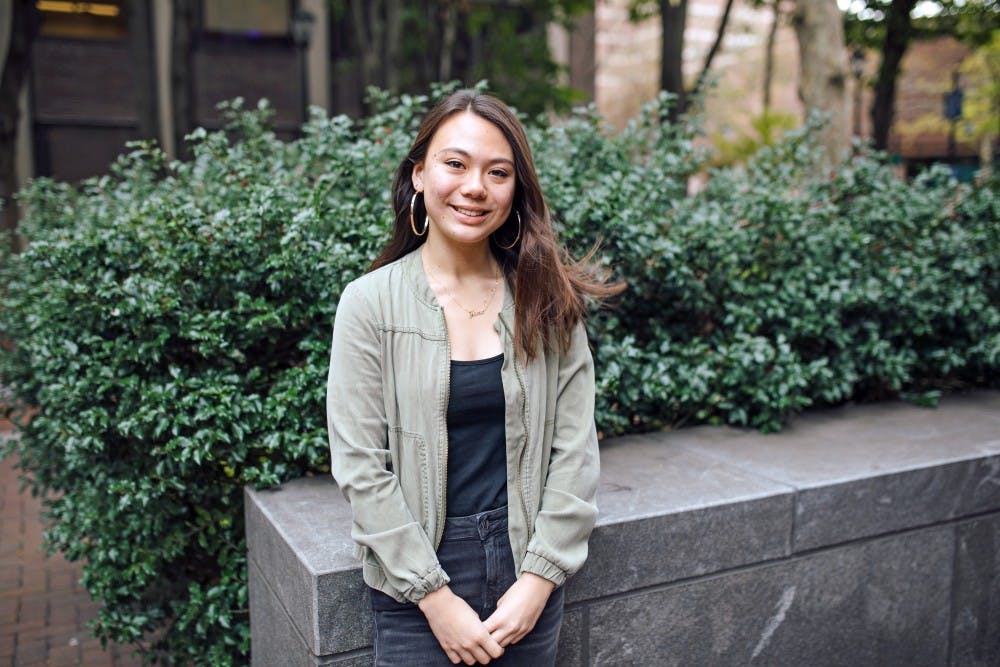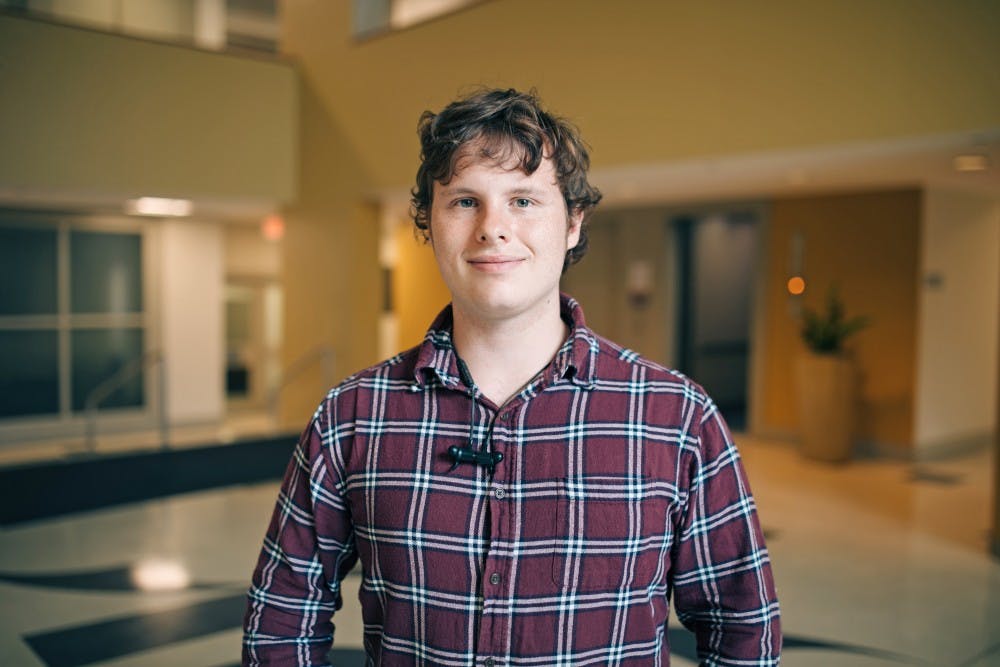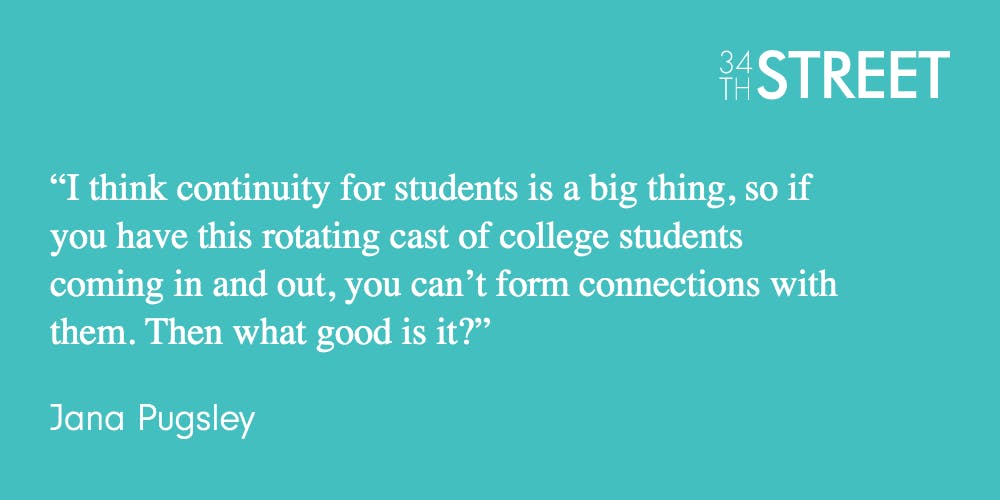Jana Pugsley (C‘22) was used to the metal detector that greeted her at the entrance of Central High School every morning. She was used to subsidized breakfast and lunch, to bathrooms without toilet paper, to letters in the mail from teachers begging parents for photocopy paper.
Central High School is one of the best public schools in Philadelphia. Jana had to submit an application and sit for an interview to get accepted, and students boast some of the highest test scores in the city. Even so, the systemic poverty plaguing Philadelphia schools also affected Central, Jana says.
“Teachers spent years and years without contracts, so they weren’t getting their raises and their pensions,” she says. “We could tell it was really hard for our teachers because they were like, ‘Well, if my work isn’t being valued by the state and if I’m not getting paid, then I don’t care.’” Although Jana says teachers at Central almost always showed up to class, other schools struggled with teacher absenteeism. Teachers in the district often weren’t at school to mark the even greater number of students who were absent.
“There was just this feeling that nobody really cared,” she says. “Nobody cared about being there.”
Jana came to Penn wanting to change that. She joined GEAR UP, one of the many tutoring programs at Penn, the first semester of freshman year. There are more than a dozen organizations serving K–12 schools through the Netter Center, the Civic House, Academically–Based Community Service (ABCS) courses, and other groups on campus. Every week, hundreds of Penn students travel to public schools to work with kids on math homework, reading comprehension, and college applications.
But like many students, Jana quickly discovered that tutoring was not what she expected it to be. She says that inadequate training left her feeling “wildly unprepared” to teach high school students, and attitudes of privilege from wealthier Penn tutors made her question the effectiveness of the program.

Jana Pugsley
There were also fundamental issues with the city’s public school system that only large–scale funding and intervention could fix. In a situation where the responsibility for improving education has been pushed onto under–qualified college students, the kids and families in Philadelphia bear the brunt of the consequences.
At Penn, 46% of students are white, by far the largest demographic. The average family income is $195,500, and 96% of students graduate within six years.
In the School District of Philadelphia, 48.49% of students are black, and 21.71% are Hispanic. Every student receives free breakfast and lunch because the entire district is classified as economically disadvantaged. The average graduation rate for public high schools in the city is 82.18%, but many schools trend lower: at Strawberry Mansion High School in North Philadelphia, 40% of students graduate.
As a university at the forefront of research in dozens of fields, Penn assists public schools through volunteer tutor programs. But while the university projects itself as a benevolent community provider, that image isn't fully convincing to many Penn students—much less to Philadelphia residents.
Because of its status as a nonprofit, the university doesn’t pay property taxes, despite taking up miles of land and pushing native residents and businesses out through gentrification. Philadelphia public schools get more than half of their revenue from these taxes. Protests pushing for Penn to pay PILOTS—payments in lieu of taxes—to help local schools have gained momentum over the years, but the university has been staunch in opposing them. Vice President of University Communications Stephen MacCarthy has argued that the community service that students do more than makes up the difference, citing Penn’s contribution to “over 500 activities going on in 248 schools in every catchment area throughout the District.”
But the large number of tutoring programs doesn’t fully conceal their sometimes shallow impact. Despite getting a C in high school algebra, Jana was assigned by her program to work with students on the same math textbook she’d struggled to understand.
“I think [the students] could tell that I wasn’t super confident in my skills, and that wasn’t good because I was supposed to be in there helping them,” she says. For GEAR UP, tutor training consists of several orientation sessions focusing on the basics of mentoring and the college application process, as well as mandated reporter training and some history of the Philadelphia school district. There were also biweekly meetings where tutors could reflect on their experiences in the classroom.
Jana says that overall, the training was good at teaching Penn students how to help with college applications, but there wasn’t any support for specific subjects like algebra. Although she didn’t want to teach a subject she didn’t know well, GEAR UP was in need of math tutors, so she hesitantly agreed. In the process, Jana felt she lost the respect of her kids, and she, in turn, lost respect for GEAR UP.
Other tutoring programs at Penn show a similar gap in training. In a Netter Center program last year at Sayre High School, there was no training at all. Theresa Simmonds, coordinator for the Netter Center’s College Access and Career Readiness programs, acknowledged that the pilot program did not include an orientation or recurring meetings. In an email, she confirmed that the program has been canceled.
Although Jana felt unprepared for her program, she had advantages that many other Penn tutors didn’t. She knew how Philly public schools worked, and she didn’t flinch when students yelled at their teachers or broke out into fights. But many tutors didn’t come from the same background, and they were quick to pass judgment. As an FGLI student, Jana says other Penn students often carry attitudes about wealth that are alienating to her, including a misplaced admiration for her background as a “badass” inner–city school student.
“People think it’s clout or whatever that you went to a rough school, and they think that you’re tough or something,” she says. The poverty of her school district seemed minimized by richer students. She’s also felt excluded from conversations about experiences her family and school couldn’t afford to provide, like expensive sports, music lessons, and standardized test prep.
“It’s definitely alienating when people are like, ‘Oh, well if you didn’t have this very specific set of experiences, then you’re other.’ And I think that’s something that’s very common with people that went to not just Central, but a lot of Philly high schools,” she says.
Jana’s biggest criticism of training was its failure to fully address the environment of Philadelphia public schools, how it might differ from tutors’ educational backgrounds, and what kinds of stereotypical assumptions Penn students should be careful not to adopt. She felt that many tutors were not prepared to work with students who misbehaved or showed little interest in learning, and they were judgmental as a result.
“If the students see that the tutors don’t know how to handle a situation, they’re not going to take you seriously,” Jana says. “They’re not going to trust you. And then if they see if you quickly pass judgment, they’re not going to want to interact with you. It really boils down to trust.”
“The students, they’re human beings, they are perfectly capable of taking care of themselves,” says Carter Gale (C ‘20). Carter is a lead coach for GEAR UP who recruits, trains, and manages tutors in addition to tutoring himself. He’s been with the program since he came to Penn, and he’s not shy about how much he believes in tutoring as a positive force for change.
Even though Carter has dedicated much of his time at Penn to GEAR UP, he admits that many tutors come into the program with misconceptions. “Everyone at Penn has an attitude of changing the world,” he says. “This kind of white–saviorism that a lot of Penn students have is like, ‘I’m going to change the world and fix these kids.’ They’re human beings, they can handle themselves. You don’t need to save them.”

Carter Gale
A white savior complex, as Carter points out, may often arise from good intentions. A student from a more privileged background wants to help out other students who may not have all the opportunities they've had. They’re excited to become tutors so they can lift students out of violence and poverty, unaware that they’re implicitly supporting racial stereotypes by viewing themselves as “saviors” for marginalized groups.
Carter says this is a significant concern in tutoring, as many Penn students unknowingly carry this attitude. But through time and more experience, Carter believes that tutors address their biases and become better teachers.
Based upon her own experiences with wealthier Penn students, Jana is more skeptical. Frustrated after several attempts to work with group coordinators, she quit tutoring after a year, highlighting another weakness with a volunteer model of tutoring: low commitment. When people can easily skip training sessions, push tutoring off for a week because of midterms, or quit out of the blue, what does that mean for public school students?
“I think continuity for students is a big thing, so if you have this rotating cast of college students coming in and out, you can’t form connections with them. Then what good is it?” Jana says that even tutors who decided to sign on for another semester frequently skipped their tutoring sessions, feeding into the environment of instability that surrounds kids learning in an underfunded school district.
Lack of training and commitment, significant as they are, only brush the surface of the fractured relationship between the university and Philly public schools. It’s an uncomfortable reality that Penn students receive vastly different opportunities than the public school students who live next door.
Penn is currently in the process of constructing New College House West for its students, a $163 million project. In Philadelphia public schools, old, decaying buildings expose children to dangerous levels of asbestos and lead dust. One six–year–old consumed lead chips that fell from the ceiling at school for two months and suffered lasting brain damage. According to the Philadelphia Inquirer, the school district needs $3 billion over ten years for all necessary construction and repairs on their buildings.
Twenty–three schools closed in 2013 because of a projected $1.35 billion budget deficit. Thousands of students left behind friends and teachers for new schools in unfamiliar neighborhoods.
“We got letters home with teachers begging parents for photocopy paper,” Jana says. At her high school, lack of funding permeated every aspect of her learning. This included the struggle to be known by her guidance counselor, who had a caseload of 600 students. How much can any tutor, well–trained or not, help a school that’s falling apart inside and out?

“There’s not always the infrastructure,” says Simmonds. She notes teachers, principals, and Netter Center staff at the schools are often putting out multiple fires at the same time, from low test scores to absenteeism to serious incidents of violence against both students and faculty.
“The schools are underserved, they don’t have enough staff, and knowing how to use volunteers is a skill,” Simmonds says. “The needs of the students are so great that all of the services that you want to provide—all the activities and making use of all the volunteers—may just have to go down the priority list because there are other things that have to be dealt with immediately.”
Teachers and students are being pulled in all directions constantly, and even an inch of progress can seem incredibly fragile in the face of so many challenges.
“If things start to slide, and you don’t take care of it pretty quickly, it can get to a point where you’re doing a mountain of lifting to get it back to where it was,” Simmonds says.
There’s not much a single Penn student can do to combat systemic issues. There’s a lot the university can do—but decidedly hasn’t. While claiming that “Penn actively supports the Philadelphia School District” through its outreach programs, the university avoids the responsibility for letting kids go to school with overworked teachers and administrators, in classrooms full of toxic chemicals, taught by inexperienced volunteers.
The only school Penn directly contributes to through funding is Penn Alexander, a K–8 school where 30% of students have family ties to the university. The result has been decisive: with the additional $700,000 the university gives to Alexander every year, the school boasts top test scores, student awards, and an abundance of resources that surrounding schools simply don’t have.
Jana and Carter have a few ideas to better structure the tutoring programs. Besides providing more subject–specific training, Jana thinks deeper lessons in the history of Philly school systems and a “more trauma–informed approach” would help Penn students become better tutors. Trauma–informed teaching takes into account the various forms of stress students can face on a daily basis, including poverty, neglect, mental health issues, unstable living situations, and abuse. Instead of reacting negatively when students act out, Jana says, tutors should learn to suspend judgement and understand how traumatic experiences might affect kids’ behavior.
As a lead coach, Carter is working on having older, more experienced members watch over new tutors for the first few sessions, which he thinks will help people learn more quickly on the job.
“Our training model is very much, you go in for the first time with other people who have been doing it longer, and doing more of that, I think, is helpful,” he says. “[Tutoring] is not something you can train in a classroom or an orientation session. It’s something that you need to kind of learn through doing.”
But there’s a fundamental tradeoff between better training and student interest, Simmonds says. Right now, there are hundreds of Penn students who travel to local public schools to teach, but how many would stay if programs instituted stricter application processes, longer and more in–depth preparation, and mandatory cultural sensitivity training? According to Carter, who also works for the Netter Center’s internal evaluation team, the majority of people who join GEAR UP already quit after a year with the program, joining the “rotating cast” that’s so disruptive to students’ development.
The future of Philadelphia public schools is volatile, and the extent to which Penn tutoring programs can help is uncertain. The divide between Penn and public schools is growing, cementing the university’s position as an institution unattainable to many Philadelphia students. Without more funding for the district, the efforts of outreach programs designed to close the gap are stunted, and tutors are, at worst, transitory—a temporary mark on a kid’s life for a semester or two, set to disappear.
Chelsey Zhu is a features staff writer for Street.
An earlier version of this article stated that the West Philadelphia Tutoring Program had only one orientation; it has multiple. An earlier version of this article also conflated details of Central High School, where Jana Pugsley (C’22) attended high school, and Benjamin Franklin High School, where Jana tutored. This article has been updated to reflect this correction. 34th Street regrets these errors.
